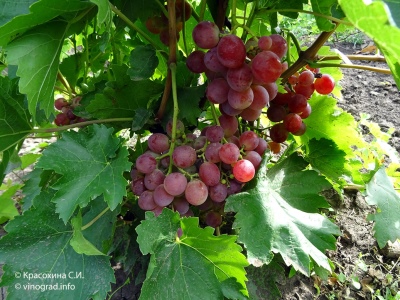
- Authors: Zagorulko Vitaly Vladimirovich
- Appointment: dining room
- Berry color: rose red
- Taste: harmonious, nutmeg
- Ripening period: very early
- Frost resistance, ° C: -24
- Bunch weight, g: 400-1200
- Flower type: bisexual
- Peeling: Yes
- Damage by wasps: stable
Lovers of sweet grapes will love Rosemus. Some consider its berries too cloying, but true sweet tooth and grape connoisseurs argue that its taste is almost ideal for table varieties. In addition, Rosemus is resistant to diseases, does not require complex care, so many gardeners are happy to allocate space for the bushes of this grape on their site.
Breeding history
The Rosemus grape variety was bred in Ukraine. Its author, an amateur breeder with many years of experience in the cultivation of grapes Zagorulko Vitaly Vladimirovich, received it by repeated repeated crosses of hybrids obtained from green and pink grape varieties - Arcadia and Sofia.
Description
Table variety of hybrid form. Vigorous bushes. Leaves are green, moderately dissected, mostly five-lobed. On the shoots, 3 inflorescences are usually formed.
The fruits have an attractive presentation, unusual taste and aroma. During transportation, Rosemus grapes practically do not undergo any changes in appearance and do not deteriorate. Can be transported over long distances.
Ripening period
Very early ripening grapes. In the conditions of Zaporozhye, it ripens in the last decade of July. The growing season lasts only 90-100 days.
Bunches
Bunches of Rosemus are of different sizes, conical or cylindro-conical. Their weight ranges from 400 g to 1000 g. Some brushes weigh up to 1.2 kg. Peas are sometimes observed.
Berries
Rounded, less often slightly oval in shape, the berries are collected in strong beautiful clusters. The color of the grapes comes in various shades of pink. Mostly they are dark pink, red-pink. The berries are large, rarely crack. Their weight is about 12 g.
Taste
Under the thin skin there is a fleshy, dense, very sweet pulp with a combination of harmonious and nutmeg flavors. Many grape connoisseurs believe that Rosemus has a characteristic tea rose aroma. The skin is not felt during the meal.
Yield
The variety is characterized by an average yield of bushes.


Growing features
Rosemus grapes must be placed in well-lit areas. Can be planted on the south side of a country house, a large barn. It is better to form the vines using the ceiling method (on an arch, arbor).
Landing
Planting is best done in spring. To do this, about 20 days before planting, prepare pits about 70 cm wide, about 60 cm deep. If the soil is heavy, then it is necessary to lay a small layer of rubble (about 5 cm) at the bottom of the depression.
After planting, the bushes are watered abundantly with warm water.

Pollination
The flowers are bisexual, they do not require additional pollination.
Pruning
The pruning is standard, it is better to carry it out in the fall. It is also necessary to remove branches that do not bear fruit. They carry out sanitary pruning of the plant, get rid of damaged shoots.

Watering
Watering is necessary once a week. If dry weather without precipitation is established, the amount of irrigation is increased to 2-3 times a week.


Frost resistance and the need for shelter
Rosemus bushes can withstand severe frosts (up to 24 degrees below zero). If in the growing region there is a possibility of a temperature drop below this value, the bushes need shelter for the winter.

Diseases and pests
Rosemus is highly resistant to fungal diseases. Tolerance is found (3 points on a five-point scale) to such common diseases as mildew, gray rot, powdery mildew.
The bushes can be infected with grape crayfish. Since it is not easy to fight this disease, it is necessary to carry out preventive treatment of the plant, for example, with the preparations "Fitolavin", "Phytoplasmin". Young seedlings should be carefully inspected for signs of disease. It is not recommended to abuse the use of nitrogen fertilizers.
A feature of the variety that cannot but rejoice is that wasps practically do not damage Rosemus berries.

If a grape is exposed to any disease or insect, this always affects its appearance.
Storage
The best storage method is to leave the bunches on the bushes. So they will not lose their taste for a long time and will gain sugar. But if you do not take off the harvest by the end of September, the taste of the berries will change, they will lose the flavor of nutmeg.
Store in a cool, dark place after collection. You can lay out the bunches in a thin layer in boxes. Hanging storage shows good results.
The bunches of Rosemus are quite dense, and the skin on the berries is thin, if only a few berries undergo rotting, this can lead to spoilage of the entire grape bunch. Therefore, it is recommended to periodically inspect the bunches, removing grape bunches from the storage sites with signs of spoilage and putrefactive processes.











































































